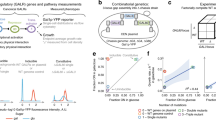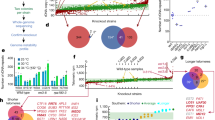Abstract
Variation in transcriptional regulation is thought to be a major cause of phenotypic diversity1,2. Although widespread differences in gene expression among individuals of a species have been observed3,4,5,6,7,8, studies to examine the variability of transcription factor binding on a global scale have not been performed, and thus the extent and underlying genetic basis of transcription factor binding diversity is unknown. By mapping differences in transcription factor binding among individuals, here we present the genetic basis of such variation on a genome-wide scale. Whole-genome Ste12-binding profiles were determined using chromatin immunoprecipitation coupled with DNA sequencing in pheromone-treated cells of 43 segregants of a cross between two highly diverged yeast strains and their parental lines. We identified extensive Ste12-binding variation among individuals, and mapped underlying cis- and trans-acting loci responsible for such variation. We showed that most transcription factor binding variation is cis-linked, and that many variations are associated with polymorphisms residing in the binding motifs of Ste12 as well as those of several proposed Ste12 cofactors. We also identified two trans-factors, AMN1 and FLO8, that modulate Ste12 binding to promoters of more than ten genes under α-factor treatment. Neither of these two genes was previously known to regulate Ste12, and we suggest that they may be mediators of gene activity and phenotypic diversity. Ste12 binding strongly correlates with gene expression for more than 200 genes, indicating that binding variation is functional. Many of the variable-bound genes are involved in cell wall organization and biogenesis. Overall, these studies identified genetic regulators of molecular diversity among individuals and provide new insights into mechanisms of gene regulation.
This is a preview of subscription content, access via your institution
Access options
Subscribe to this journal
Receive 51 print issues and online access
$199.00 per year
only $3.90 per issue
Buy this article
- Purchase on Springer Link
- Instant access to full article PDF
Prices may be subject to local taxes which are calculated during checkout





Similar content being viewed by others
Accession codes
Primary accessions
Gene Expression Omnibus
Data deposits
Raw data are deposited in the Gene Expression Omnibus (GEO) database (http://www.ncbi.nlm.nih.gov/geo/) under accession number GSE19636.
References
King, M. C. & Wilson, A. C. Evolution at two levels in humans and chimpanzees. Science 188, 107–116 (1975)
Pennisi, E. Searching for the genome’s second code. Science 306, 632–635 (2004)
Morley, M. et al. Genetic analysis of genome-wide variation in human gene expression. Nature 430, 743–747 (2004)
Schadt, E. E. et al. Genetics of gene expression surveyed in maize, mouse and man. Nature 422, 297–302 (2003)
Brem, R. B., Yvert, G., Clinton, R. & Kruglyak, L. Genetic dissection of transcriptional regulation in budding yeast. Science 296, 752–755 (2002)
Yvert, G. et al. Trans-acting regulatory variation in Saccharomyces cerevisiae and the role of transcription factors. Nature Genet. 35, 57–64 (2003)
Ronald, J., Brem, R. B., Whittle, J. & Kruglyak, L. Local regulatory variation in Saccharomyces cerevisiae. PLoS Genet. 1, e25 (2005)
Li, Y. et al. Mapping determinants of gene expression plasticity by genetical genomics in C. elegans. PLoS Genet. 2, e222 (2006)
Borneman, A. R. et al. Divergence of transcription factor binding sites across related yeast species. Science 317, 815–819 (2007)
Wilson, M. D. et al. Species-specific transcription in mice carrying human chromosome 21. Science 322, 434–438 (2008)
Roberts, C. J. et al. Signaling and circuitry of multiple MAPK pathways revealed by a matrix of global gene expression profiles. Science 287, 873–880 (2000)
Mancera, E. et al. High-resolution mapping of meiotic crossovers and non-crossovers in yeast. Nature 454, 479–485 (2008)
MacIsaac, K. D. et al. An improved map of conserved regulatory sites for Saccharomyces cerevisiae. BMC Bioinformatics 7, 113 (2006)
Rockman, M. V. & Kruglyak, L. Genetics of global gene expression. Nature Rev. Genet. 7, 862–872 (2006)
Hwang-Shum, J. J. et al. Relative contributions of MCM1 and STE12 to transcriptional activation of a- and α-specific genes from Saccharomyces cerevisiae. Mol. Gen. Genet. 227, 197–204 (1991)
Pramila, T. et al. Conserved homeodomain proteins interact with MADS box protein Mcm1 to restrict ECB-dependent transcription to the M/G1 phase of the cell cycle. Genes Dev. 16, 3034–3045 (2002)
Jin, R., Dobry, C. J., McCown, P. J. & Kumar, A. Large-scale analysis of yeast filamentous growth by systematic gene disruption and overexpression. Mol. Biol. Cell 19, 284–296 (2008)
Kobayashi, O., Suda, H., Ohtani, T. & Sone, H. Molecular cloning and analysis of the dominant flocculation gene FLO8 from Saccharomyces cerevisiae. Mol. Gen. Genet. 251, 707–715 (1996)
Smukalla, S. et al. FLO1 is a variable green beard gene that drives biofilm-like cooperation in budding yeast. Cell 135, 726–737 (2008)
Liu, H., Styles, C. A. & Fink, G. R. Saccharomyces cerevisiae S288C has a mutation in FLO8, a gene required for filamentous growth. Genetics 144, 967–978 (1996)
Gimeno, C. J. & Fink, G. R. Induction of pseudohyphal growth by overexpression of PHD1, a Saccharomyces cerevisiae gene related to transcriptional regulators of fungal development. Mol. Cell. Biol. 14, 2100–2112 (1994)
Rupp, S. et al. MAP kinase and cAMP filamentation signaling pathways converge on the unusually large promoter of the yeast FLO11 gene. EMBO J. 18, 1257–1269 (1999)
Borneman, A. R. et al. Target hub proteins serve as master regulators of development in yeast. Genes Dev. 20, 435–448 (2006)
Ni, L. et al. Dynamic and complex transcription factor binding during an inducible response in yeast. Genes Dev. 23, 1351–1363 (2009)
Lefrançois, P. et al. Efficient yeast ChIP-Seq using multiplex short-read DNA sequencing. BMC Genomics 10, 37 (2009)
Zhang, Y. et al. Model-based analysis of ChIP-Seq (MACS). Genome Biol. 9, R137 (2008)
Gordon, D. B., Nekludova, L., McCallum, S. & Fraenkel, E. TAMO: a flexible, object-oriented framework for analyzing transcriptional regulation using DNA-sequence motifs. Bioinformatics 21, 3164–3165 (2005)
Eisen, M. B., Spellman, P. T., Brown, P. O. & Botstein, D. Cluster analysis and display of genome-wide expression patterns. Proc. Natl Acad. Sci. USA 95, 14863–14868 (1998)
Subramanian, A. et al. Gene set enrichment analysis: a knowledge-based approach for interpreting genome-wide expression profiles. Proc. Natl Acad. Sci. USA 102, 15545–15550 (2005)
Wei, W. et al. Genome sequencing and comparative analysis of Saccharomyces cerevisiae strain YJM789. Proc. Natl Acad. Sci. USA 104, 12825–12830 (2007)
Aparicio, O., Geisberg, J. V. & Struhl, K. Chromatin immunoprecipitation for determining the association of proteins with specific genomic sequences in vivo. Curr. Protoc. Cell Biol. Chapter 17, Unit–17.7 (2004)
Rozowsky, J. et al. PeakSeq enables systematic scoring of ChIP-seq experiments relative to controls. Nature Biotechnol. 27, 66–75 (2009)
Robertson, G. et al. Genome-wide profiles of STAT1 DNA association using chromatin immunoprecipitation and massively parallel sequencing. Nature Methods 4, 651–657 (2007)
Acknowledgements
We thank J. Gagneur for comments on data analysis, the Cornell Microarray Facility for helping with the gene expression experiments, A. Lin for preprocessing of microarray data, C. Yellman for technical help, and Yale University Biomedical High Performance Computing Center (NIH grant RR19895) for providing computation resources. Research was funded by National Institutes of Health (NIH) grants to M.S., H.Z. and L.M.S.
Author Contributions W.Z. and M.S. designed the study, E.M. and L.S. provided yeast strains, W.Z. performed experiments, W.Z. and H.Z. analysed the data, E.M., L.M.S. and M.S. provided suggestions in data analysis, and all authors co-wrote the paper.
Author information
Authors and Affiliations
Corresponding author
Ethics declarations
Competing interests
The authors declare no competing financial interests.
Supplementary information
Supplementary Figures
This file contains Supplementary Figures 1-8 with Legends. (PDF 2556 kb)
Supplementary Tables
This file contains Supplementary Tables 1-7 (PDF 1126 kb)
Rights and permissions
About this article
Cite this article
Zheng, W., Zhao, H., Mancera, E. et al. Genetic analysis of variation in transcription factor binding in yeast. Nature 464, 1187–1191 (2010). https://doi.org/10.1038/nature08934
Received:
Accepted:
Published:
Issue Date:
DOI: https://doi.org/10.1038/nature08934
This article is cited by
-
Unravel the regulatory mechanism of Yrr1p phosphorylation in response to vanillin stress in Saccharomyces cerevisiae
Microbial Cell Factories (2023)
-
Hypoxia-mediated regulation of mitochondrial transcription factors in renal epithelial cells: implications for hypertensive renal physiology
Hypertension Research (2021)
-
MCHM Acts as a Hydrotrope, Altering the Balance of Metals in Yeast
Biological Trace Element Research (2020)
-
Insights about collective decision-making at the genetic level
Biophysical Reviews (2020)
-
Dynamic evolution of regulatory element ensembles in primate CD4+ T cells
Nature Ecology & Evolution (2018)
Comments
By submitting a comment you agree to abide by our Terms and Community Guidelines. If you find something abusive or that does not comply with our terms or guidelines please flag it as inappropriate.



